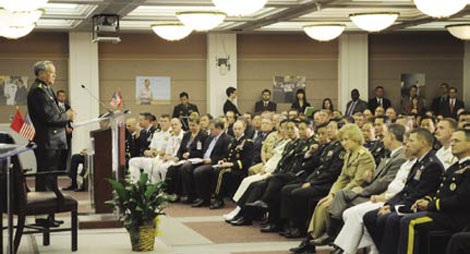Life
A wait-and-see game after bilateral talks
Updated: 2011-05-20 11:16
By Zhang Wenzong (China Daily)
|
General Chen Bingde addresses the audience at the US National Defense University on Wednesday. Bing Li / For China Daily |
BEIJING - The third round of the China-US Strategic and Economic Dialogue (S&ED), held in Washington last week, was seen as a great success by the Chinese government.
China and the United States reportedly laid out 48 strategic agreements as well as 20 economic deals in the discussions. Both also signed on to promote growth, sustainability and cooperation.
Success at the talks was crucial for both nations. After President Hu Jintao's visit to the US in January, the S&ED was seen as a stabilizing force behind the China-US relationship. Ultimately, the discussions have likely ushered in new opportunities for greater cooperation between the world's two largest economies. But what exactly did the discussions achieve? Here's a breakdown:
I. The dialogue reduced many administrative costs within the bilateral relationship.
For China, the talks were carried out to hammer out preliminary agreements achieved during President Hu's visit in January. For the US, the S&ED helped promote its domestic economy and remove doubts within China about the US' economic outlook and strategies.
The two countries will most likely have broader, closer and more extensive economic cooperation after the talks. The China-US relationship is one of the most important and complex bilateral relationships in the world. In the past few years, the two countries have clashed on many issues such as the exchange rate and Tibet.
The US and China have built a greater understanding for each other from the talks and are reportedly trying to expand on deals in a host of different sectors.
But this S&ED is different from the past. This dialogue established a strategic security dialogue covering the economy and military affairs, which could help reduce management costs within the bilateral relationship and improve efficiency.
II. The economic dialogue is a win-win result.
The apparently fruitful results of this dialogue are clear when you look at the economies of each nation. Through this dialogue, China and the US signed a comprehensive framework, which was regarded by both nations as a milestone for economic ties because it serves as a guideline for future trade.
During the S&ED, there were some differences and sensitive issues discussed, such as human rights, the yuan exchange rate and intellectual property rights.
Through the S&ED, the US reportedly receives specific benefits from China, while China gets some clear commitments from the US.
Whether and when the US can fulfill its commitments and treat China as an equal economic partner remains to be seen. No matter which party receives more benefits, the signing of this framework provides enough to fuel the development of the two large economic engines, which are strongly connected with each other.
III. The security dialogue enhanced strategic mutual trust.
It was the first time for senior Chinese military officials to take part in the S&ED. This was very beneficial for both nations in trying to clear up misunderstandings.
With the development of China's military power, it's been said that the US is afraid that the rise of China's military power will threaten the US' military advantages. The dialogue provided the US with some knowledge of China's strategic abilities and intentions.
Theoretically speaking, communication between the two countries' militaries can help avoid clashes. Yet it is not realistic to expect breakthroughs through dialogue because I believe that the US will never give trying to exert pressure on China's military power. There is clearly deep suspicions between the two.
But the establishment of the strategic security dialogue signals that the relationship between the two military powers has taken a step forward toward institutionalization. Now the two sides must take communication even further in the areas of strategy, tactics and cooperation in non-traditional security issues.
This round of talks has also achieved consensus in the area of diplomacy. The establishment of a US-China system of consulting on Asia-Pacific regional issues makes clear that the two countries are trying to be open about the region.
As a result of the S&ED, China and the US have agreed to hold a new round of talks toward policy planning as well as what their stances are on Africa, Latin America, South Asia and Middle Asia, which could be very constructive for their bilateral relationship.
The author is a research associate at the China Institutes of Contemporary International Relations.
China Daily
Specials

Suzhou: Heaven on Earth
Time-tested adages sing praises of Suzhou, and Michael Paul Franklin finds it's not hard to understand why on a recent visit.

The sky's the limit
Chinese airline companies are increasingly recruiting pilots and flight attendants as the industry experiences rapid expansion.

Diving into history
China's richest cultural heritage may lie in the deep, like exhibits in a giant underwater museum.
